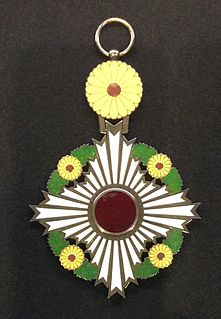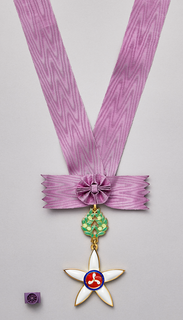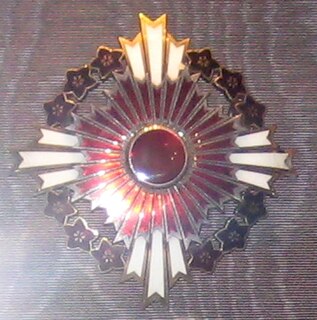 W
WThe Japanese honours system originated in the 1870s, shortly after the Meiji Restoration, and was modeled on European honour systems. The first order, the Imperial Order of Meiji was established in 1875, and was later renamed as the Order of the Rising Sun.
 W
WThe Supreme Order of the Chrysanthemum is Japan's highest order. The Grand Cordon of the Order was established in 1876 by Emperor Meiji of Japan; the Collar of the Order was added on 4 January 1888. Unlike its European counterparts, the order may be conferred posthumously.
 W
WThe Order of Culture is a Japanese order, established on February 11, 1937. The order has one class only, and may be awarded to men and women for contributions to Japan's art, literature, science, technology, or anything related to culture in general; recipients of the order also receive an annuity for life. The order is conferred by the Emperor of Japan in person on Culture Day each year.
 W
WThe Order of the Paulownia Flowers is an order presented by the Japanese government. Established in 1888 during the Meiji Restoration as the highest award in the Order of the Rising Sun; however, since 2003 it has been an Order in its own right. The only grade of the order is Grand Cordon of the Order of the Paulownia Flowers , which ranks higher than the Order of the Rising Sun but lower than the Order of the Chrysanthemum.
 W
WThe Order of the Precious Crown is a Japanese order, established on January 4, 1888 by Emperor Meiji of Japan, and the second lowest ranking of the Japanese orders currently awarded. Originally the order had five classes, but on April 13, 1896 the sixth, seventh and eighth classes were added.
 W
WThe Order of the Rising Sun is a Japanese order, established in 1875 by Emperor Meiji. The Order was the first national decoration awarded by the Japanese government, created on 10 April 1875 by decree of the Council of State. The badge features rays of sunlight from the rising sun. The design of the Rising Sun symbolizes energy as powerful as the rising sun in parallel with the "rising sun" concept of Japan.
 W
WThe Order of the Sacred Treasure is a Japanese order, established on 4 January 1888 by Emperor Meiji as the Order of Meiji. Originally awarded in eight classes, since 2003 it has been awarded in six classes, the lowest two medals being abolished that year. The most widely conferred Japanese order, it is awarded to those who have made distinguished achievements in research fields, business industries, healthcare, social work, state/local government fields or the improvement of life for handicapped/impaired persons.